Seed Packet Information: Hills of California
Hills of California
We hope you enjoy your seeds from the CNPS SCV Wildflower Ambassadors program. This plant mix is designed to provide flowers over a period of three months in the spring and early summer in a sunny area.
Planting Instructions
Fall through winter is the ideal time to start growing California native wildflowers as these have adapted to capitalize on the fall and winter rains (October-February is best) and bloom in spring. They may be planted through April, but after that it is best to wait until at least September to plant them as they do not do well when planted in late spring or summer.
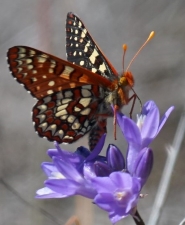 Choose A Site & Prepare Your Soil
Choose A Site & Prepare Your Soil
- Choose a spacious site in full sun.
- Prepare your soil (or several very large pots), by removing all existing growth and debris. If your soil is clay, break it up with some compost or cactus soil (sold at nurseries).
- Water thoroughly to help seeds settle into the soil. Continue to water a few times a week, unless it rains, so they don’t dry out after germinating. Seeds should sprout in one to three weeks.
- After you plant your seeds, let the area ‘go natural’ by leaving the leaf litter on the ground. While many butterflies go into chrysalis on stems or other hard surfaces like branches, many others go into chrysalis in the debris. If you rake or blow it, you could accidentally kill or throw them away.
Avoid using pesticides anywhere in your garden, it will kill the beneficial insects such as bees, butterflies, moths, and ladybugs that you are trying to attract. Try to ignore bugs, as they are part of the ecosystem (for instance, hummingbirds eat aphids). If you hose the plant or try to remove pests you may dislodge butterfly or ladybug eggs or kill tiny caterpillars. Avoid using herbicides as they also poison the ecosystem you are trying to nurture.
Plants In The Hills Of California Mix
- Farewell to Spring, Clarkia amoena (hosts White Lined Sphinx Moth, Clark’s Day Sphinx Moth)
- Mountain Garland, Clarkia unguiculata (hosts White Lined Sphinx Moth, Clark’s Day Sphinx Moth)
- Chinese Houses, Collinsia heterophylla (hosts Variable Checkerspot)
- California Poppy, Eschscholzia californica (useful to pollinators, hosts Acmon Blue, Dotted Blue, Mormon Metalmark, etc.)
- Globe Gilia, Gilia capitata (host to Fairy Longhorn Moth)
- Goldfields, Lasthenia glabrata (hosts Small Heliothodes Moth)
- Tidy Tips, Layia platyglossa (hosts Small Heliothodes Moth)
- Blue Flax, Linum lewisii (hosts Variegated Fritillary)
- Miniature Lupine, Lupinus bicolor (hosts Painted Lady, Acmon Blue, Gray Hairstreak)
- Sky Lupine, Lupinus nanus (hosts Orange Sulphur, Painted Lady, Acmon Blue, Gray Hairstreak)
- Arroyo Lupine, Lupinus succulentus (hosts West Coast Lady, Painted Lady, Acmon Blue, Gray Hairstreak)
- Five Spot, Nemophila maculate (hosts Funereal Duskywing)
- Baby Blue-Eyes, Nemophila menziesii (hosts Owlet Moth)
- Lacy Phacelia, Phacelia tanacetifolila – (hosts Bilobed Looper Moth, beloved by bees)
The list of moths and butterflies hosted by these plants is just a sample, these plants are a host to many more - a comprehensive list of butterflies each plant hosts, and details about the plants and butterflies, can be found at Calscape.org
*”Host” = key food source for the caterpillars of these particular butterflies, that co-evolved to specialize over thousands of years. Butterflies die out without these plants.
Seed Packet Information: California Shady Wildflower Mix
California Shady Wildflower Mix
We hope you enjoy your seeds from the CNPS SCV Wildflower Ambassadors program. This plant mix is designed to provide flowers over a period of three months in the spring and early summer in a shady area.
Planting Instructions
Fall through winter is the ideal time to start growing California native wildflowers as these have adapted to capitalize on the fall and winter rains (October-February is best) and bloom in spring. They may be planted through April, but after that it is best to wait until at least September to plant them as they do not do well when planted in late spring or summer.
 Choose A Site & Prepare Your Soil
Choose A Site & Prepare Your Soil
- Choose a spacious site in full sun.
- Prepare your soil (or several very large pots), by removing all existing growth and debris. If your soil is clay, break it up with some compost or cactus soil (sold at nurseries).
- Water thoroughly to help seeds settle into the soil. Continue to water a few times a week, unless it rains, so they don’t dry out after germinating. Seeds should sprout in one to three weeks.
- After you plant your seeds, let the area ‘go natural’ by leaving the leaf litter on the ground. While many butterflies go into chrysalis on stems or other hard surfaces like branches, many others go into chrysalis in the debris. If you rake or blow it, you could accidentally kill or throw them away.
Avoid using pesticides anywhere in your garden, it will kill the beneficial insects such as bees, butterflies, moths, and ladybugs that you are trying to attract. Try to ignore bugs, as they are part of the ecosystem (for instance, hummingbirds eat aphids). If you hose the plant or try to remove pests you may dislodge butterfly or ladybug eggs or kill tiny caterpillars. Avoid using herbicides as they also poison the ecosystem you are trying to nurture.
Plants In The California Shady Wildflower Mix
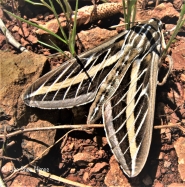
- Mountain Garland, Clarkia unguiculata (hosts Clark's Day Sphinx Moth)
- Chinese Houses, Collinsia heterophylla (hosts Variable Checkerspot)
- Baby Blue-Eyes, Nemophila menziesii (hosts Owlet Moth)
- Five Spot, Nemophila maculate (hosts Alfalfa Looper Moth)
- Farewell to Spring, Clarkia amoena (hosts White Lined Sphinx Moth)
- Punchbowl Godetia, Clarkia bottae (hosts Mariposa Forester)
- Bird’s Eye Gilia, Gilia tricolor (hosts Spotted Sun Straw Moth)
- Grand Linanthus, Linanthus grandifloras (hosts Buckwheat Borer Moth)
The list of moths and butterflies hosted by these plants is just a sample, these plants are a host to many more - a comprehensive list of butterflies each plant hosts, and details about the plants and butterflies, can be found at Calscape.org
*”Host” = key food source for the caterpillars of these particular butterflies, that co-evolved to specialize over thousands of years. Butterflies die out without these plants.
Seed Packet Information: California Pollinator Seed Mix
California Pollinator Seed Mix
We hope you enjoy your seeds from the CNPS SCV Wildflower Ambassadors program. This plant mix provides a variety of sun loving California native annuals and perennials that sustain pollinators over a long season..
Planting Instructions
Fall through winter is the ideal time to start growing California native wildflowers as these have adapted to capitalize on the fall and winter rains (October-February is best) and bloom in spring. They may be planted through April, but after that it is best to wait until at least September to plant them as they do not do well when planted in late spring or summer.
 Choose A Site & Prepare Your Soil
Choose A Site & Prepare Your Soil
- Choose a spacious site in full sun.
- Prepare your soil (or several very large pots), by removing all existing growth and debris. If your soil is clay, break it up with some compost or cactus soil (sold at nurseries).
- Water thoroughly to help seeds settle into the soil. Continue to water a few times a week, unless it rains, so they don’t dry out after germinating. Seeds should sprout in one to three weeks.
- After you plant your seeds, let the area ‘go natural’ by leaving the leaf litter on the ground. While many butterflies go into chrysalis on stems or other hard surfaces like branches, many others go into chrysalis in the debris. If you rake or blow it, you could accidentally kill or throw them away.
Avoid using pesticides anywhere in your garden, it will kill the beneficial insects such as bees, butterflies, moths, and ladybugs that you are trying to attract. Try to ignore bugs, as they are part of the ecosystem (for instance, hummingbirds eat aphids). If you hose the plant or try to remove pests you may dislodge butterfly or ladybug eggs or kill tiny caterpillars. Avoid using herbicides as they also poison the ecosystem you are trying to nurture.
Plants In The California Pollinator Seed Mix
- Yarrow, Achillea millefolium (hosts Northern Scurfy Quaker, Olive Arches, Yarrow Plume Moth, Smeathmann's Aethes Moth)
- Mountain Garland, Clarkia unguiculata (hosts Clark's Day Sphinx Moth)
- Fort Miller Clarkia, Clarkia williamsonii (hosts Clark's Day Sphinx Moth, White-lined Sphinx, Pacific Green Sphinx Moth, Mariposa Forester)
- California Poppy, Eschscholzia californica (useful to pollinators, hosts Acmon Blue, Dotted Blue, Mormon Metalmark, etc.)Lupinus micrantha densiflorus himes crop small
Central Valley Gumplant, Grindelia camporum (hosts Orange Tortrix Moth, Cremastobombycia grindeliella)
- Dense-flowered Lupine, Lupinus microcarpus var. densiflorus (hosts Painted Lady, Acmon Blue, Boisduval's Blue, Silvery BLue, Orange Sulphur)
- Rock Phacelia, Phacelia californica (hosts Oidaematophorus phaceliae, Clepsis fucana, Bilobed Looper Moth, Orange Tortrix Moth)
- Great Valley Phacelia, Phacelia ciliata (hosts Bilobed Looper Moth, Orange Tortrix Moth, Geranium Plumed Moth)
- Bolander's Phacelia, Phacelia bolanderi (hosts Bilobed Looper Moth, Orange Tortrix Moth, Geranium Plumed Moth)
- Serpentine Sunflower, Helianthus bolanderi (hosts Painted Lady, Milbert's Tortoiseshell, California Patch)
The list of moths and butterflies hosted by these plants is just a sample, these plants are a host to many more - a comprehensive list of butterflies each plant hosts, and details about the plants and butterflies, can be found at Calscape.org
*”Host” = key food source for the caterpillars of these particular butterflies, that co-evolved to specialize over thousands of years. Butterflies die out without these plants.
CNPS SCV Wildflower Ambassadors
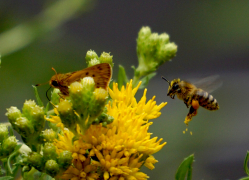 CNPS SCV Wildflower Ambassadors (WFA) promote the use of native plants in gardens to create habitat for our native bees, butterflies, birds and more. They do this by providing information and free native seeds at events and library talks, assisting with tours of local native gardens and other activities. Above all, they have a good time while inspiring people to start their own native gardens and create habitat for our native bees, butterflies, birds and more.
CNPS SCV Wildflower Ambassadors (WFA) promote the use of native plants in gardens to create habitat for our native bees, butterflies, birds and more. They do this by providing information and free native seeds at events and library talks, assisting with tours of local native gardens and other activities. Above all, they have a good time while inspiring people to start their own native gardens and create habitat for our native bees, butterflies, birds and more.
For more information and questions email us at This email address is being protected from spambots. You need JavaScript enabled to view it.. Want to join? Apply here: https://cnps-scv.org/wfa-app.
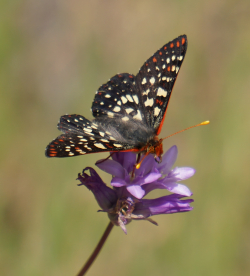 Seed and Garden Information
Seed and Garden Information
Did you receive a free wildflower seed packet from us? Go here for planting instructions and more information about the seeds you received.
Learn more about habitat gardens and native plants on this webpage.
Wildflower Seed Planting
Grow Wildflowers!
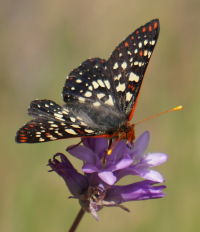
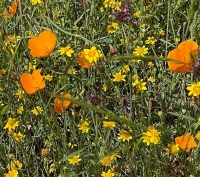 Each seed packet you receive from us contains California native wildflowers in rich hues of gold, orange, pink, purple and blue that will cover two to three square feet or several large pots. You can scatter these seeds in an area planted with native grasses for a meadow effect.
Each seed packet you receive from us contains California native wildflowers in rich hues of gold, orange, pink, purple and blue that will cover two to three square feet or several large pots. You can scatter these seeds in an area planted with native grasses for a meadow effect.
Scattering a packet of native wildflower seeds is a joyful way to restore lost essential habitat while enhancing your gardening experience. We hope you revel in the beauty of the flowers, colorful caterpillars, variety of pollinators, baby birds, and the dance of life in your garden. Together, we can bring back butterflies, bees, and birds. Attend one of our events to receive free seeds. We do not mail seeds.
Planting Instructions
- Choose a site in full sun to partial shade.
- Prepare your soil by removing all existing growth and debris. If your soil is clay, break it up with some compost or cactus mix (sold at nurseries).
- Scatter your seeds over the prepared area. For more even coverage, you can mix your seeds with a little sand before scattering them.
- Water thoroughly to help seeds settle into the soil. Continue to water a few times a week, unless it rains, so they don’t dry out after germinating. Seeds should sprout in one to three weeks.
- After your plants are several inches tall, let the area ‘go natural’ by leaving the leaf litter on the ground. While many butterflies go into chrysalis on stems or other hard surfaces like branches, many others go into chrysalis in the debris. If you rake or blow it, you could accidentally kill or throw them away.
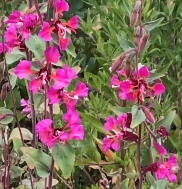 The beauty, color, and scent of flowers bring us joy. However, it's crucial to remember that for bees, butterflies, and birds, flowers serve as a vital source of nourishment for their survival. Plants and flowers provide bees with pollen, butterflies and moths with nectar, and caterpillars with essential food in the form of leaves. Butterflies sip nectar from many flowers but lay their eggs exclusively on specific host plants that will nourish their offspring. The Variable Checkerspot, Silvery Blue, and other butterflies and moths depend on these plants as a food source for their caterpillars. In turn, these caterpillars play a crucial role in the survival of local birds, as 96% of the birds that visit your yard rely on caterpillars to feed their babies. To learn more about this fascinating relationship, consider reading Nature's Best Hope by Doug Tallamy or watching this video. Share this information with your friends and neighbors!
The beauty, color, and scent of flowers bring us joy. However, it's crucial to remember that for bees, butterflies, and birds, flowers serve as a vital source of nourishment for their survival. Plants and flowers provide bees with pollen, butterflies and moths with nectar, and caterpillars with essential food in the form of leaves. Butterflies sip nectar from many flowers but lay their eggs exclusively on specific host plants that will nourish their offspring. The Variable Checkerspot, Silvery Blue, and other butterflies and moths depend on these plants as a food source for their caterpillars. In turn, these caterpillars play a crucial role in the survival of local birds, as 96% of the birds that visit your yard rely on caterpillars to feed their babies. To learn more about this fascinating relationship, consider reading Nature's Best Hope by Doug Tallamy or watching this video. Share this information with your friends and neighbors!
Want more seeds? Check our list of places to buy native seeds.
Contact us with questions at: This email address is being protected from spambots. You need JavaScript enabled to view it.
Resources for Gardeners
The California Native Plant Society (CNPS) is a science-based organization founded in 1965 with a mission to conserve California native plants and their natural habitats, and increase understanding, appreciation, and horticultural use of native plants. The Santa Clara Valley chapter covers Santa Clara County and southern San Mateo County. Check out the great resources on our website and the numerous talks on native plant gardening and native plant science on our YouTube channel. We also have chapter fieldtrips, online plant sales, and other exciting events like our annual Growing Natives Garden tour. The CNPS state website also has excellent resources and information to get you started with native plant science or gardening.
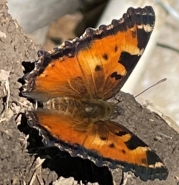 Want to find more California Native plants specific to your area, and the butterflies that use them as host plants? Then check out the wonderful CNPS Calscape website, which includes descriptions and planting information about every California native plant and links to native plant nurseries all over the state. For a user guide to using this amazing resource, watch this talk.
Want to find more California Native plants specific to your area, and the butterflies that use them as host plants? Then check out the wonderful CNPS Calscape website, which includes descriptions and planting information about every California native plant and links to native plant nurseries all over the state. For a user guide to using this amazing resource, watch this talk.
Discover flora and fauna in your region and across the globe, and even post your own observations on the iNaturalist app.
Seek answers to questions:
Why should we grow native plants to save birds and butterflies? Listen to Susan Karasoff here.
How can you restore nature in your garden? Dennis Mudd shares his insights
Where can you find more information about pollinator plants? Juanita Salisbury is an expert who talks about this.
When should you plant, water, prune, or leave things alone? Helen Popper shares a month-by-month guide for California gardeners.
What planting methods and soil will ensure success? Haven Kiers from UC Davis shares some research.
Need Plants? Find nurseries and plant sales using our list.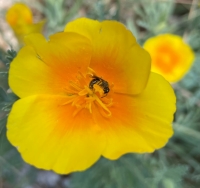
Seeking a few more butterfly resources? The Xerces Society is a great resource as well as the Bay Area Wildlife resource website.
Looking for a list of great books for gardening with native plants and ifor wildlife? Go to our resource page for books.
Need help getting started with a native plant garden? Tips are available in this video
Want to see most of California’s native habitats in one location? Check out the Regional Botanic Garden in Tilden Park.
Here is a list of public gardens with native plants.
Field Trip! Chapter field trips are listed here or on our Meetup page.
Contact us with questions at: This email address is being protected from spambots. You need JavaScript enabled to view it.
 Choose A Site & Prepare Your Soil
Choose A Site & Prepare Your Soil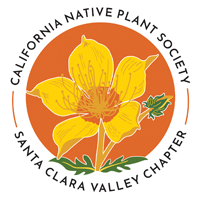


 CNPS SCV Wildflower Ambassadors (WFA) promote the use of native plants in gardens to create habitat for our native bees, butterflies, birds and more. They do this by providing information and free native seeds at events and library talks, assisting with tours of local native gardens and other activities. Above all, they have a good time while inspiring people to start their own native gardens and create habitat for our native bees, butterflies, birds and more.
CNPS SCV Wildflower Ambassadors (WFA) promote the use of native plants in gardens to create habitat for our native bees, butterflies, birds and more. They do this by providing information and free native seeds at events and library talks, assisting with tours of local native gardens and other activities. Above all, they have a good time while inspiring people to start their own native gardens and create habitat for our native bees, butterflies, birds and more.  Seed and Garden Information
Seed and Garden Information
 Each seed packet you receive from us contains California native wildflowers in rich hues of gold, orange, pink, purple and blue that will cover two to three square feet or several large pots. You can scatter these seeds in an area planted with native grasses for a meadow effect.
Each seed packet you receive from us contains California native wildflowers in rich hues of gold, orange, pink, purple and blue that will cover two to three square feet or several large pots. You can scatter these seeds in an area planted with native grasses for a meadow effect.  The beauty, color, and scent of flowers bring us joy. However, it's crucial to remember that for bees, butterflies, and birds, flowers serve as a vital source of nourishment for their survival. Plants and flowers provide bees with pollen, butterflies and moths with nectar, and caterpillars with essential food in the form of leaves. Butterflies sip nectar from many flowers but lay their eggs exclusively on specific host plants that will nourish their offspring. The Variable Checkerspot, Silvery Blue, and other butterflies and moths depend on these plants as a food source for their caterpillars. In turn, these caterpillars play a crucial role in the survival of local birds, as 96% of the birds that visit your yard rely on caterpillars to feed their babies. To learn more about this fascinating relationship, consider reading
The beauty, color, and scent of flowers bring us joy. However, it's crucial to remember that for bees, butterflies, and birds, flowers serve as a vital source of nourishment for their survival. Plants and flowers provide bees with pollen, butterflies and moths with nectar, and caterpillars with essential food in the form of leaves. Butterflies sip nectar from many flowers but lay their eggs exclusively on specific host plants that will nourish their offspring. The Variable Checkerspot, Silvery Blue, and other butterflies and moths depend on these plants as a food source for their caterpillars. In turn, these caterpillars play a crucial role in the survival of local birds, as 96% of the birds that visit your yard rely on caterpillars to feed their babies. To learn more about this fascinating relationship, consider reading  Want to find more California Native plants specific to your area, and the butterflies that use them as host plants? Then check out the wonderful CNPS
Want to find more California Native plants specific to your area, and the butterflies that use them as host plants? Then check out the wonderful CNPS 